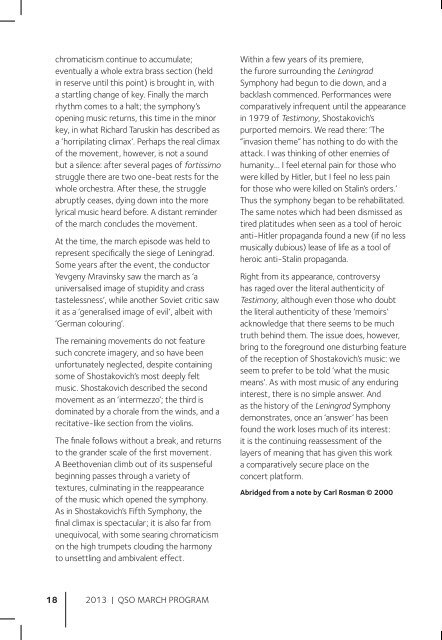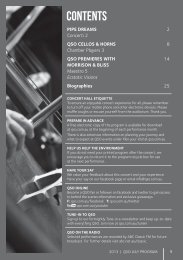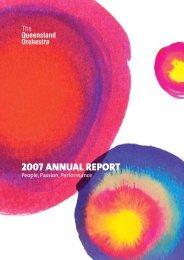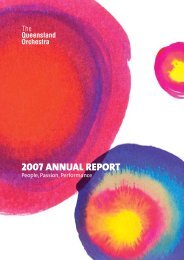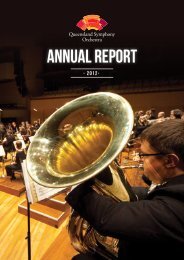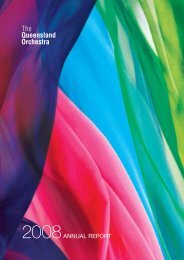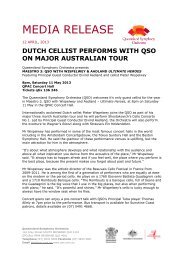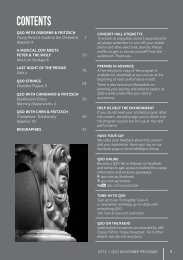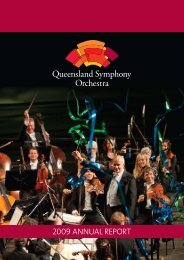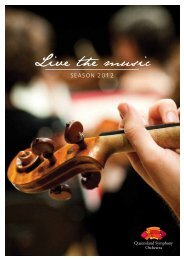March 2013 - Queensland Symphony Orchestra
March 2013 - Queensland Symphony Orchestra
March 2013 - Queensland Symphony Orchestra
You also want an ePaper? Increase the reach of your titles
YUMPU automatically turns print PDFs into web optimized ePapers that Google loves.
chromaticism continue to accumulate;<br />
eventually a whole extra brass section (held<br />
in reserve until this point) is brought in, with<br />
a startling change of key. Finally the march<br />
rhythm comes to a halt; the symphony’s<br />
opening music returns, this time in the minor<br />
key, in what Richard Taruskin has described as<br />
a ‘horripilating climax’. Perhaps the real climax<br />
of the movement, however, is not a sound<br />
but a silence: after several pages of fortissimo<br />
struggle there are two one-beat rests for the<br />
whole orchestra. After these, the struggle<br />
abruptly ceases, dying down into the more<br />
lyrical music heard before. A distant reminder<br />
of the march concludes the movement.<br />
At the time, the march episode was held to<br />
represent specifically the siege of Leningrad.<br />
Some years after the event, the conductor<br />
Yevgeny Mravinsky saw the march as ‘a<br />
universalised image of stupidity and crass<br />
tastelessness’, while another Soviet critic saw<br />
it as a ‘generalised image of evil’, albeit with<br />
‘German colouring’.<br />
The remaining movements do not feature<br />
such concrete imagery, and so have been<br />
unfortunately neglected, despite containing<br />
some of Shostakovich’s most deeply felt<br />
music. Shostakovich described the second<br />
movement as an ‘intermezzo’; the third is<br />
dominated by a chorale from the winds, and a<br />
recitative-like section from the violins.<br />
The finale follows without a break, and returns<br />
to the grander scale of the first movement.<br />
A Beethovenian climb out of its suspenseful<br />
beginning passes through a variety of<br />
textures, culminating in the reappearance<br />
of the music which opened the symphony.<br />
As in Shostakovich’s Fifth <strong>Symphony</strong>, the<br />
final climax is spectacular; it is also far from<br />
unequivocal, with some searing chromaticism<br />
on the high trumpets clouding the harmony<br />
to unsettling and ambivalent effect.<br />
Within a few years of its premiere,<br />
the furore surrounding the Leningrad<br />
<strong>Symphony</strong> had begun to die down, and a<br />
backlash commenced. Performances were<br />
comparatively infrequent until the appearance<br />
in 1979 of Testimony, Shostakovich’s<br />
purported memoirs. We read there: ‘The<br />
“invasion theme” has nothing to do with the<br />
attack. I was thinking of other enemies of<br />
humanity… I feel eternal pain for those who<br />
were killed by Hitler, but I feel no less pain<br />
for those who were killed on Stalin’s orders.’<br />
Thus the symphony began to be rehabilitated.<br />
The same notes which had been dismissed as<br />
tired platitudes when seen as a tool of heroic<br />
anti-Hitler propaganda found a new (if no less<br />
musically dubious) lease of life as a tool of<br />
heroic anti-Stalin propaganda.<br />
Right from its appearance, controversy<br />
has raged over the literal authenticity of<br />
Testimony, although even those who doubt<br />
the literal authenticity of these ‘memoirs’<br />
acknowledge that there seems to be much<br />
truth behind them. The issue does, however,<br />
bring to the foreground one disturbing feature<br />
of the reception of Shostakovich’s music: we<br />
seem to prefer to be told ‘what the music<br />
means’. As with most music of any enduring<br />
interest, there is no simple answer. And<br />
as the history of the Leningrad <strong>Symphony</strong><br />
demonstrates, once an ‘answer’ has been<br />
found the work loses much of its interest:<br />
it is the continuing reassessment of the<br />
layers of meaning that has given this work<br />
a comparatively secure place on the<br />
concert platform.<br />
Abridged from a note by Carl Rosman © 2000<br />
Backstage Pass<br />
PIERS LANE, PIANO<br />
You performed with the QSO in July last<br />
year. After that you were travelling to<br />
Alaska for the first time. What was the<br />
highlight of that trip?<br />
I was only in Anchorage on that trip, but am<br />
going again this June and shall also visit magical<br />
Sitka. The concerts were great fun though – a<br />
standing ovation for the newly commissioned<br />
piece we presented. We had been concerned<br />
about how something so contemporary and<br />
hard-hitting would go down, but somebody<br />
said during the interval that it was the most<br />
exciting thing to happen in Alaska for fifteen<br />
years – that sort of reaction thrills a performer!<br />
This year you will be performing Mozart’s<br />
Piano Concerto No.21 with the QSO.<br />
Mozart composed 27 concertos for piano<br />
and orchestra. How many of these have you<br />
performed and which is your favourite?<br />
I’ve only performed ten or eleven of them,<br />
though some of those many times. But how<br />
could I choose a favourite? They’re all sublime!<br />
The first concerto I ever learned was the A<br />
major K488 and that, of course, has a special<br />
place in my heart.<br />
Can you describe the significance of the<br />
silver badge you wear when you perform?<br />
Some years ago, when I was playing at the Blair<br />
Atholl Festival in Scotland, all of the artists were<br />
asked to wear Malcolm Appleby’s jewellery.<br />
He’s a famous silversmith and goldsmith<br />
– does wondrous things! The soprano had<br />
on a necklace worth thousands, but I wore<br />
Pianohead (it has a grand piano for a head),<br />
one of thirty heads Malcolm had done as pins<br />
and brooches. I kept it and it has lived on my<br />
tails ever since – it’s become a sort of talisman<br />
I guess.<br />
Last time you were here we noticed some<br />
very bright socks! When did this signature<br />
fashion style form?<br />
I was touring with Brett Dean and other friends<br />
for Musica Viva back in 2004 and needed to<br />
buy a black shirt for a lunchtime concert. Miki<br />
Tsunoda the violinist and I went into a shop in<br />
Sydney and there was a dazzling pair of socks<br />
in the window. She encouraged me to buy them<br />
(it’s all her fault!) and I subsequently wore them<br />
under my tails when I gave the Opening Recital<br />
of the Sydney Piano Competition that year.<br />
They went down a treat and loud socks have<br />
been a feature of my concert attire ever since,<br />
for better or for worse! The New York Sun once<br />
gave me a review which said ‘Mr Lane came on<br />
stage in his conservative British tails, but when<br />
he sat down, he revealed a startling pair of<br />
socks. His playing was more like his socks! ‘<br />
After that, I couldn’t go back to black, could I?<br />
18 <strong>2013</strong> | QSO MARCH PROGRAM <strong>2013</strong> | QSO MARCH PROGRAM 19


